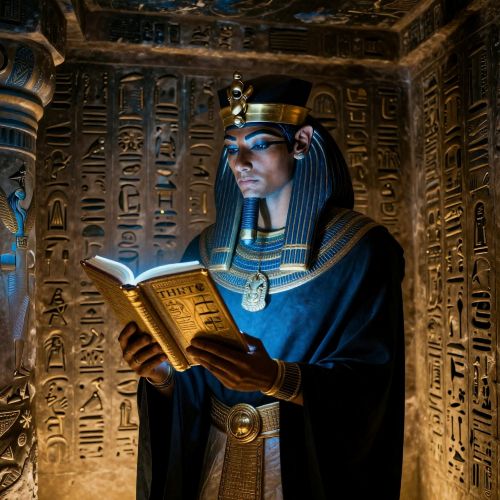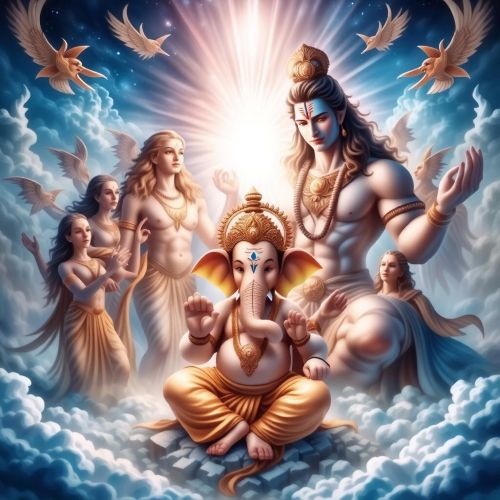Kamadhenu’s Boon: The Divine Gift of Abundance and Fulfillment
Listen
At a glance
| Description | |
|---|---|
| Mythology | Indian Mythology |
| Bestowed Upon | Sage Vasishta |
| Granted By | Kamadhenu (Divine origin) |
| Primary Effect | Infinite abundance and wish fulfillment |
| Conditions Attached | Must be used for righteous and spiritual purposes |
Kamadhenu’s Boon
Introduction
Kamadhenu, revered as the celestial cow in Hindu mythology, stands as an eternal symbol of abundance, purity, and divine generosity. Her legendary gift—known as Kamadhenu’s Boon—represents the universe’s capacity to fulfill righteous desires through spiritual harmony and devotion. More than a myth, this boon embodies the Vedic principle of dharma (righteousness) guiding abundance, illustrating how spiritual integrity aligns with material and emotional fulfillment. Across ages, Kamadhenu’s story continues to inspire devotion, gratitude, and the recognition of nature’s boundless benevolence.
Mythological Background
According to Hindu scriptures like the Mahabharata and Puranas, Kamadhenu—also known as Surabhi—emerged during the Samudra Manthan, the cosmic churning of the ocean. As gods (Devas) and demons (Asuras) worked together to retrieve treasures from the depths of the ocean, Kamadhenu appeared, radiating celestial light and divine fragrance. She was a manifestation of the cosmic principle of sustenance, bridging heaven and earth.
Her name derives from Sanskrit: Kāma (desire) and Dhenu (cow), literally meaning “the cow that fulfills desires.” She is described as a divine being with a cow’s body, a woman’s face, wings of a bird, and a peacock’s tail—symbolizing her transcendence beyond the earthly realm. Kamadhenu became the mother of all cows and a sacred emblem of nourishment, grace, and the cyclical renewal of life.
Granting of the Boon/Blessing
Unlike typical deities who grant boons upon request, Kamadhenu’s gift is inherent—her very existence radiates blessing. When the gods entrusted her to Sage Vashishta, one of the seven great sages (Saptarishis), she revealed her divine powers by producing limitless milk, food, and resources to sustain his hermitage and guests.
Her blessing extended beyond material sustenance. When King Vishwamitra attempted to seize her by force, Kamadhenu manifested celestial armies from her body to protect Vashishta. This act reaffirmed her role as a guardian of righteousness and demonstrated that her blessings favor the pure-hearted over the power-hungry. Kamadhenu’s Boon, thus, became synonymous with divine protection, prosperity, and the fruits of devotion.
Nature of the Boon/Blessing
Kamadhenu’s Boon embodies the universe’s endless capacity to provide when approached with faith and moral integrity. Her gifts are not finite or conditional—they flow naturally to those who align with dharma. The nature of this boon can be understood through four dimensions:
Abundance: Her milk symbolizes inexhaustible sustenance, purity, and life-giving energy.
Fulfillment: Every righteous wish—whether material or spiritual—finds realization through her grace.
Protection: She guards her devotees and sustains cosmic balance, creating harmony between nature and spirit.
Spiritual Elevation: Her blessings encourage compassion, gratitude, and detachment from greed.
Kamadhenu’s Boon teaches that divine wealth arises from harmony with the sacred order, not from force or desire.
Recipients and Key Figures
The most famous recipient of Kamadhenu’s Boon is Sage Vashishta, whose devotion made him worthy of possessing the divine cow. Through her grace, he sustained his hermitage, nurtured disciples, and upheld the sacred laws of hospitality and charity.
King Vishwamitra, driven by envy, attempted to capture Kamadhenu, igniting a legendary conflict that led to his transformation—from a warrior king into a sage. This narrative underscores that the divine cannot be conquered through might but only through spiritual evolution.
Kamadhenu’s legacy continued through her celestial offspring, notably her daughter Nandini, who inherited her miraculous powers and served other sages. Together, they personify the continuity of divine grace across generations of devotees.
Effects and Consequences
Kamadhenu’s Boon brought not only abundance but also moral enlightenment. For the virtuous, her presence ensured prosperity, peace, and spiritual fulfillment. For those driven by greed, her story served as a cautionary tale.
Vashishta’s serene abundance contrasted sharply with Vishwamitra’s turmoil, illustrating that the fruits of Kamadhenu’s Boon cannot be forced—they manifest naturally through humility and devotion. The myth emphasizes the ethical use of resources, the sanctity of giving, and the balance between wealth and wisdom.
Her divine grace symbolizes the law of cause and effect—those who respect creation and live in harmony with the sacred are sustained by it; those who exploit or desecrate it invite ruin.
Symbolism and Spiritual Meaning
Kamadhenu’s Boon holds layered symbolic meanings within Hindu thought. She embodies Gau Mata—the Universal Mother who nourishes all beings. Her overflowing milk represents divine love, purity, and the endless flow of energy sustaining the cosmos.
Spiritually, Kamadhenu represents the synthesis of material and spiritual abundance—artha and moksha—reminding humanity that wealth serves a higher purpose when aligned with virtue. Her multi-formed appearance signifies unity in diversity, connecting gods, humans, and nature through mutual interdependence.
In Vedic astrology, Kamadhenu is associated with the Pushya Nakshatra, an auspicious lunar constellation symbolizing nourishment, growth, and prosperity.
Cultural Impact and Legacy
Kamadhenu’s influence extends far beyond myth into India’s living culture. The reverence for cows in Hinduism stems from her archetypal role as the provider of life and sustenance. Worship of Kamadhenu or her earthly embodiments occurs during rituals like Gopashtami and Govatsa Dwadashi, seeking her blessings for prosperity and familial well-being.
In art and temple carvings, she is portrayed surrounded by deities, symbolizing divine unity. Her iconography continues to inspire modern representations of fertility, abundance, and ecological balance. Contemporary environmental movements and sustainable living philosophies often draw upon her symbolism—honoring the sacred bond between humans, animals, and nature.
Kamadhenu’s Boon thus continues to illuminate the eternal truth that generosity and gratitude are the real sources of prosperity, reminding humanity to live in harmony with the divine rhythms of the Earth.
Source
Hindu Culture Hub. (2025). A closer look at Kamadhenu: The sacred symbol of abundance. https://hinduculturehub.com/symbols-icons-art/kamadhenu/
Hindu Temple Talk. (2023, May 11). Kamadhenu: The divine cow of abundance and prosperity. https://hindutempletalk.org/2023/05/11/kamadhenu-the-divine-cow-of-wishes/
Doniger, W. (2009). The Hindus: An alternative history. Penguin Books.
Kinsley, D. (1988). Hindu goddesses: Visions of the divine feminine in the Hindu religious tradition. University of California Press.
Bhattacharyya, N. N. (1996). History of Indian religious thought. Munshiram Manoharlal Publishers.
Klostermaier, K. K. (2007). A survey of Hinduism. SUNY Press.
Zimmer, H. (1946). Myths and symbols in Indian art and civilization. Princeton University Press.
Lovenspire. (2025, October 2). Kamadhenu Cow: The Divine Cow of Abundance and Prosperity. https://lovenspire.com/kamadhenu-cow-abundance
Cosmic Insights. (2025, November 9). Kamadhenu – Powerful Ritual for Wealth, Prosperity and Blessings. https://blog.cosmicinsights.net/kamadhenu-ritual-wealth
99Pandit. (2025, September 11). Kamdhenu Cow Story: The Sacred Cow of Hindu Mythology. https://99pandit.com/kamdhenu-cow-story
Print Bharat. (2025, January 27). What does Kamadhenu symbolize? https://printbharat.com/kamadhenu-symbolism
Sahapedia. (2004, January 31). Kamadhenu: The Pleasures of Giving. https://sahapedia.org/kamadhenu-pleasures-of-giving
Vedansh Craft. (2025, August 21). The Sacred Story of Kamadhenu, the Divine Cow. https://vedanshcraft.com/kamadhenu-sacred-story
Gold Art India. (2025, February 23). The Sacred Kamdhenu Cow: Abundance & Blessings. https://goldartindia.com/sacred-kamdhenu-cow
Frequently Asked Questions
What is Kamadhenu’s Boon in Hindu mythology?
Kamadhenu’s Boon refers to her divine power to grant abundance, fulfill righteous desires, and sustain life through her sacred energy.
Who received Kamadhenu’s Boon?
The sage Vashishta was the foremost recipient, who used her blessings to sustain his hermitage and uphold dharma.
What does Kamadhenu symbolize?
Kamadhenu symbolizes abundance, motherhood, divine generosity, and the nurturing power of nature.
Why is Kamadhenu associated with Sage Vashishta and Vishwamitra?
Their story illustrates the contrast between spiritual wisdom and worldly ambition, showing that divine grace belongs to the virtuous, not the possessive.
How is Kamadhenu worshipped today?
She is venerated during festivals like Gopashtami and Govatsa Dwadashi, with prayers for prosperity, fertility, and protection.







